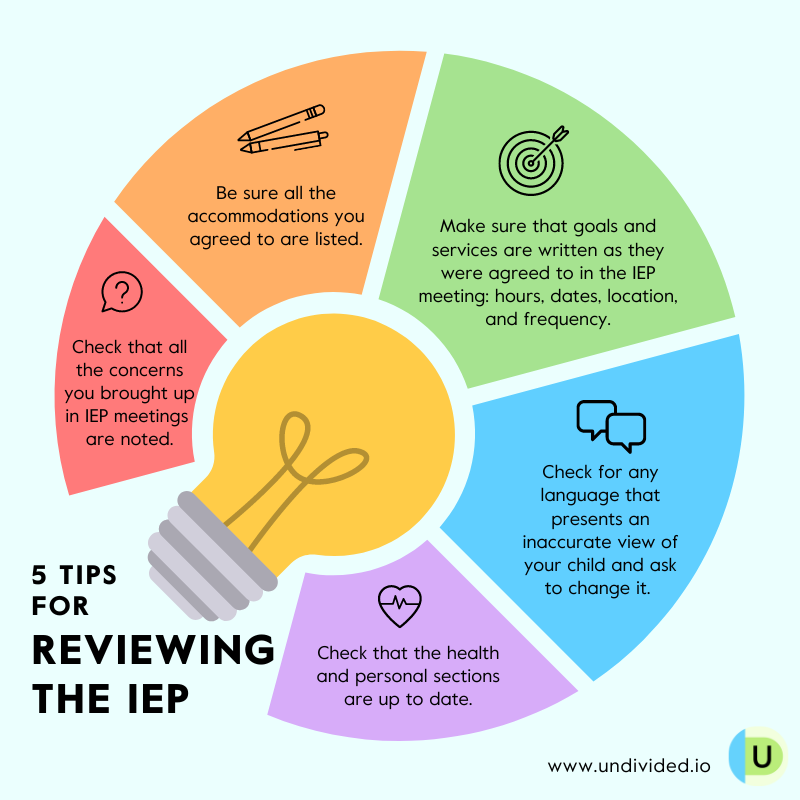How to Review Your IEP Before Signing
How does an IEP work?
The IEP is not standardized, so it looks different in different school districts. IEP forms require two different types of signature: one agreeing that you participated in the meeting, which all participants sign, and another stating that the student or parent agrees to the plan. It is always okay to sign the attendance page at every meeting. However, you should wait until you have reviewed the document at home before signing that you agree with your child’s IEP.
The district may be anxious for you to sign the IEP during the meeting because they are accountable for completing the annual IEP within a given timeline. However, it is better to take it home — you will need time to review everything in the document, process what was discussed in the meeting, and go over any points that may not have been resolved. In addition, it is a good idea to check that the pages are numbered and that none are missing.
We suggest agreeing on a timeframe in which you will return the signature page so the administrator can meet their deadline. Doing so can help reassure the team that they will complete the IEP process on time while allowing you to review each section thoroughly.
Meira Amster tells us that you can send the IEP signature page and any other letters and documents you are attaching via email, but be sure to request confirmation from the district that they received it. Dr. Pelangka suggests parents mail or deliver their letter and signature page to the district regardless of whether you send them via email so that you can be 100% sure the documents are received. If delivering in person, make sure the documents are timestamped.
What to look for in an IEP
To make the process easier for you, we have put together a list of what to look for while reviewing your child’s IEP.
Make sure that goals and services are written as they were agreed to in the meeting.
Pay particular attention to:
- Service hours and end dates.
- Location and frequency of services. For example, will they be provided weekly or monthly? Will they be push-in (services are provided in the classroom) or pull-out (services take place outside of the classroom)?
Check any sections in which you requested changes during a previous meeting that were verbally agreed upon. Dr. Pelangka suggests comparing those sections to your notes to ensure the changes you discussed were made.
- Tip: If you request any changes during an IEP meeting, ask that they be made in the moment to make sure they don’t get left out.
Do the math: if your district lists minutes of time in a SpEd or GenEd class, do they add up to the total minutes you agreed to?
Look over the accommodations list. Are all the accommodations you agreed to listed?
Check to be sure extended school year (ESY) services are included if appropriate for your child.
Read through the narrative section and note anything that is incorrectly or unfairly interpreted.
Check health and personal sections — often, these are copied over from the previous year and become outdated.
Pay close attention to the wording of the offer of FAPE.
Don’t be shy about asking to change any language that presents an inaccurate view of your child. If your IEP team has not added strength-based language to the document, you may draft a request to add it. If you shared a parent report/vision statement, it should also be included in the IEP.
Double-check that all of the concerns and questions you brought up are noted in the IEP.
If your child has benchmarks written into their IEP, ensure each one is building to the next. Also, double-check the dates for each.
If you recorded the IEP meeting, Amster suggests comparing the meeting transcript with what is written in the notes section of the IEP to ensure that the information matches.
Review and sign my child's Individualized Education Program (IEP)
What can you do if you disagree with the IEP?
If your child’s IEP is in draft form, you can email your case manager and ask if they can change it. This would equate to a “no-meet amendment,” which is primarily used for mistakes due to human error, the wrong box checked, etc. It’s important to remember that some things may be simple mistakes and can be easily fixed. Under IDEA Section 300.324(a)(4)(i), you and the school “may agree not to convene an IEP team meeting for the purposes of making those changes, and instead may develop a written document to amend or modify the child’s current IEP.”
If your child’s IEP is not in draft form (or it’s “locked”), you can request an IEP meeting and an amendment to discuss and make changes.
On the signature page, you will be given an opportunity to agree or disagree with the IEP entirely.
Partially signing the IEP
Depending on the regulations in your state, you may have the option to agree to some of the components but not to others. If you agree to some aspects of the IEP but disagree with the offer of FAPE; the duration, location, or frequency of a service; the inclusion or omission of an accommodation or modification; or the placement, consider signing a partial agreement.
If you sign a partial agreement, agreeing with most of the IEP but not certain components, the IEP will be implemented while those components will remain on “stay put,” meaning those areas of disagreement will follow whatever is in the previously signed IEP. For example, if you disagree with the district reducing your child’s speech therapy from sixty minutes to thirty minutes, a “stay put” provision will allow them to continue with sixty minutes of speech during the dispute resolution process.
According to Dr. Pelangka, in a dual-consent state such as California, the district cannot implement any new changes to an IEP without parental consent.
In this clip, Non-Attorney Education Advocate Lisa Carey breaks down the steps that occur in the disagreement process:
Amster tells us that it is important to note specific details in the IEP that you disagree with and why. You can write on the signature page itself, if there is room, or you can write a letter of disagreement that you attach to the document. (For an example of what such a letter looks like, check out our sample letter for Undivided members here.) If you attach a letter, make sure to refer to the letter on the signature page; for example, “see attached letter, dated 11/27/2022.” By indicating that a letter is attached, you can help ensure that it stays with the IEP document and does not get misplaced.
Finally, if the IEP team is not responsive to your concerns, consider pursuing other avenues of support, including a special education attorney. You can read about the differences between a special education advocate and an attorney here.
What are your next steps?
Once you’ve determined which components of your child’s IEP you disagree with, you can request:
an Independent Educational Evaluation (IEE); requesting an IEE can be beneficial if you feel new information about your child’s abilities will help you negotiate with the IEP team);
alternative dispute resolution (ADR), which is an informal process that is used to come to an agreement (it is important to note that you will not lose the right to go to due process by requesting ADR);
mediation, in which a qualified third party will mediate the resolution process; or
a due process hearing; if the district feels they offered you FAPE and a fair IEP, they can also file due process.
If you believe the district is not following federal or state laws and regulations, you may file a complaint with the state. An investigation into your complaint should be completed within sixty days.
Resolve a dispute with my IEP team
What if the school wants to exit your child from special education services?
The school should not exit a child from special education without assessments showing that the child no longer needs special education. Once those assessments are complete, there will be an IEP meeting where the result are shared, the same with any other assessment.
Remember that students cannot be exited from special education without parental consent. If you disagree and feel that your child still needs an IEP, you can disagree with the exit IEP and request assessments if the current assessments are more than two years old. If the assessments are recent, you can request IEEs at public expense in all areas of concerns. During this time, the last signed IEP is still in place.
The next steps depend on the state: in California, you should send an email outlining your disagreement with the exit plan and request that current services and goals remain in place under Stay Put. In most other states, parents have about two weeks to file a due process complaint and invoke Stay Put.
Join for free
Save your favorite resources and access a custom Roadmap.
Get StartedAuthor



